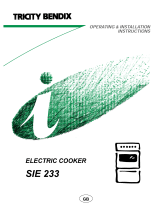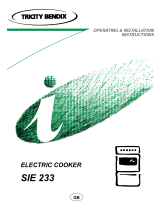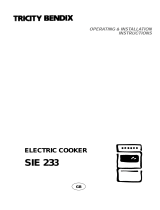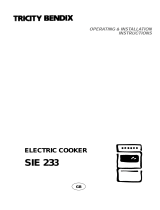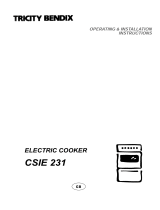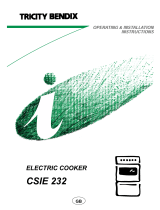Page is loading ...

1
INSTRUCTION BOOKLET
ELECTRIC COOKER
CSIE 503 W
Please read this instruction booklet before using the appliance

2
Important Safety Information
You MUST read these warnings carefully before installing or using the
appliance. If you need assistance, contact our Customer Care Department
on 08705 950950
Installation
● This cooker must be installed by qualified
personnel, according to the manufacturer’s
instructions and to the relevant British Standards.
• This cooker is heavy. Take care when moving it.
● Remove all packaging before using the cooker.
● Ensure that the electrical supply complies with the
type stated on the rating plate.
● Do not attempt to modify the cooker in any way.
Child Safety
● This cooker is designed to be operated by adults.
Do not allow children to play near or with the
cooker.
● The cooker gets hot when it is in use. Children
should be kept away until it has cooled.
● Children can also injure themselves by pulling
pans or pots off the cooker.
During Use
● This cooker is intended for domestic cooking only.
It is not designed for commercial or industrial
purposes.
● Do not use this cooker if it is in contact with
water. Do not operate the cooker with wet hands.
● Ensure the control knobs are in the ‘OFF’ position
when not in use.
● When using other electrical appliances, ensure the
cable does not come into contact with the hot
surfaces of the cooker.
● Unstable or misshapen pans should not be used on
the hob hotplates as unstable pans can cause an
accident by tipping or spillage.
● Never leave the cooker unattended when cooking
with oil and fats.
● This cooker should be kept clean at all times. A
build-up of fats or foodstuffs could result in a
fire.
● Do not store flammable materials in the storage
drawer.
● Never use plastic dishes in the oven or on the hob
hotplates.
Never line any part of the oven with
aluminium foil.
● Always ensure that the oven vent which is located
at the centre back of the hob is left unobstructed to
ensure ventilation of the oven cavity.
● Perishable food, plastic items and areosols may be
affected by heat and should not be stored above
the cooker.
● The appliance is fitted with a lid: this is designed
as a dust cover when closed, and as a splash-back
when open. Do not use for any other purpose.
● After using the cooker, the lid MUST NOT be
closed until the hob and oven are completely cold.
Service
● This cooker should only be repaired or serviced by
an authorised Service Engineer and only genuine
approved spare parts should be used.
Environmental Information
● After installation, please dispose of the packaging
with due regard to safety and the environment.
● When disposing of an old appliance, make it
unusable, by cutting off the cable.
Keep this instruction book for future
reference and ensure it is passed on
to any new owner.

3
This appliance is manufactured according
to the following EEC directives:
73/23 EEC - 90/683 EEC - 93/68 EEC -
89/336 EEC current edition.
Contents
Guide to Use the instructions
The following symbols will be found in the text to
guide you throughout the Instructions:
Safety Instructions
Step by step instructions for an
operation
Hints and Tips
☞
i
Oven Door Protection Device
All our appliances comply with the
European safety standards. Nevertheless,
in order to ensure the highest safety
level, and avoid small children to be
exposed to the heat when the appliance
is operated, it is possible to fit a special
protection device to the oven door. This
device can be purchased in our Service
Force Centres, specifying the relevant
code (35791) and the Product No. shown
on the rating plate.
Important Safety Information.............. 2
Description of the Cooker.................... 4
Control Panel ...................................... 5
The Oven Cavity.........................................5
Accessories ................................................5
Operation ............................................ 6
Electric Hotplates ......................................6
Electric Oven .............................................8
24 Hour Clock and Timer .................... 9
Before the First Use of the Oven........ 11
Using the Oven .................................. 11
Using the Fan Oven ........................... 13
Cooking Chart ................................... 14
Roasting Chart .................................. 14
Defrosting ......................................... 16
Grilling.............................................. 17
Maintenance and Cleaning................. 18
Cleaning the Oven ............................. 19
Something Not Working ..................... 21
Service and Spare Parts ..................... 22
Guarantee Conditions........................ 22
Instructions for the Installer ............. 26
Important Safety Requirements......... 26
Electrical connections....................... 27
For the User
For the Installer

4
Description of the Cooker
Cooker lid
Back left normal
hotplate
Front left rapid
hotplate
Control panel
Oven door
Front right rapid
hotplate
Back right normal
hotplate
STOP
SET
TIME
PUSH
BOTH
-
+
MINUTE MINDER
RAPID NORMAL NORMAL RAPID
OVEN & GRILL
MAINS
ON
THERMOSTAT
ON
Storage drawer

5
STOP
SET
TIME
PUSH
BOTH
-
+
MINUTE MINDER
RAPID NORMAL NORMAL RAPID
OVEN & GRILL
MAINS
ON
THERMOSTAT
ON
1. Oven Thermostat Pilot Light
2. Cooker Operation Pilot Light
3. Front left hotplate control knob
4. Back left hotplate control knob
5. Back right hotplate control knob
6. Front right hotplate control knob
7. Oven function control knob
8. Minute Minder
7654
2
1
3
Control Panel
The Oven Cavity
Grill element
Oven Light
Accessories
Oven fan
8
Grill trivet
Grill/roasting pan
Removable
handles

6
Electric Hotplates
To switch on a hotplate, turn the relevant control
knob to the required heat setting.
The control knob is numbered 0 - 6
0 - OFF
1 - Minimum
6 - Maximum.
The hob has two types of hotplates:
Normal Hotplates (Back right and left)
We recommend the plates are switched to maximum
(6) for a short while to boost the plate, and then
adjusted to the required setting.
Rapid Hotplates (Front right and left)
The rapid hotplates indicated by a red spot, will heat
up more quickly than a normal plate.
Over a period of time the red spot may
disappear, this will not affect the performance
of the hotplate.
It is important to note that the plate may smoke
a little and produce a slightly unpleasant odour
when used for the first time. This is quite
normal and will disappear after a few minutes.
Suggestions for the correct setting of the plates are
given in the following table.
Operation
OFF 0
Very Gentle 1 To keep food warm
To melt butter and chocolate
Gentle 2 To prepare cream-sauces,
stews and milk puddings
or to fry eggs
Slow 3 Dried vegetables, frozen
food, fruit, boiling water
or milk
Medium 4 Boiled potatoes, fresh
vegetables, pâtés, soups,
broths, pancakes or fish
High 5 Larger stews, meat roll, fish,
omelettes, steaks
Fast 6 Steaks, escalopes and frying.
i

7
i
Hints and Tips
Saucepans for use on solid plates should have several
characteristics:
● They should be fairly heavy duty
● They should fit the heat area exactly, or be slightly
larger for efficient use, NEVER smaller.
● They should have a flat base to ensure good
contact with the plate.
This is particularly important when using pans for
high temperature frying or pressure cooking.
As soon as liquid starts boiling, turn down the plate
control knob so that it will barely keep the liquid
simmering.
You can switch off the plate a short while before you
finish cooking, and the final stage will be completed
on the accumulated heat. Similarly, stews etc. cooked
in well covered saucepans cook at lower temperature
which is more economical.
Ensure pans are large enough to avoid
liquids being split onto the plates.
Never leave the plates on without a pan on
them or with an empty pan on them.
Take care never to lean or reach over a hot
electric plate. Always point pan handles
inward or over the work surface next to the
hob to avoid accidentally knocking over a
pan as you pass by.
Take care when frying food in hot oil or fat,
as the overheated splashes could easily
ignite.
If the control knobs become difficult to turn,
please contact your local Tricity Bendix
Service Centre.

8
Electric Oven
Oven Function Control Knob
O Oven switched off
Oven Light - The oven light will be on
without any cooking function
Fan cooking - This allows you to roast
or roast and bake simultaneously using
any shelf, without flavour transference.
50-max Range of temperature regulation for Fan
cooking
Grill - The heat comes only from the top
element.

9
1. ( - ) DECREASE CONTROL & TIMER
SETTING BUTTON
2. ( + ) INCREASE CONTROL
( ) COOKPOT SYMBOL
( ) PUSH BOTH CLOCK SETTING
SYMBOL
1. SET THE TIME OF DAY
When the electricity supply is first switched ON, the
display will flash 0.00. See Fig. 1.
Press buttons (1) and (2) together. The display will
read 88.88. See Fig. 2. Release buttons, 0.00 will
appear in the display as Fig. 3. Within 5 seconds
press button (2), 12.00 will show in the display as
Fig. 4.
Within 5 seconds, press and hold either button (1) to
decrease or button (2) to increase the time until the
correct time of day on the 24 hour clock is reached,
e.g. 14.30. See Fig. 5.
NOTE
The increase and decrease control buttons
operate slowly at first and then more
rapidly. They should be pressed separately.
Fig. 1
Fig. 2
Fig. 3
Fig. 4
Fig. 5
24 Hour Clock and Timer
STOP
SET
TIME
PUSH
BOTH
-
+
STOP
SET
TIME
PUSH
BOTH
-
+
STOP
SET
TIME
PUSH
BOTH
-
+
STOP
SET
TIME
PUSH
BOTH
-
+
STOP
SET
TIME
PUSH
BOTH
-
+
STOP
SET
TIME
PUSH
BOTH
-
+
12

10
2. THE TIMER
IMPORTANT
The timer can be used to time a set cooking period.
The timer gives an audible reminder at the end of any
period of cooking up to 23 hours and 59 minutes.
To set, press button (1) and the display will read
0 . 00
, see Fig. 6.
Release button (1) and press and hold button (2). The
display will count up in one minute intervals until the
interval to be timed is reached, e.g. 30 minutes, see
Fig. 7. If necessary, press and hold button (1) to
achieve the correct time interval.
The timer will begin to count down once set. At the
end of the timed period, the timer will click.
An audible signal will sound for up to 2 minutes.
The cookpot symbol will flash and the time of day
will show in the display. See Fig. 8.
To stop the sound press button (1). The display will
stop flashing and show the time of day, e.g. 15.00.
The cookpot symbol (
) will go out. See Fig. 9.
When cooking is complete remove food and turn
OFF oven temperature control.
3. TO CANCEL THE TIMER
Press and release button (1). Then press and hold
button (1) and the display will count down in one
minute intervals to
0 . 00
. See Fig. 10. Release
button (1).
After a few seconds the cookpot symbol will flash and
the time of day will show in the display. See Fig. 11
To reset, press button (1) and (2) together. See Fig. 12.
4. THINGS TO NOTE
The time of day must be set before the oven will
operate.
Fig. 8
Fig. 7
Fig. 9
Fig. 6
STOP
SET
TIME
PUSH
BOTH
-
+
STOP
SET
TIME
PUSH
BOTH
-
+
STOP
SET
TIME
PUSH
BOTH
-
+
STOP
SET
TIME
PUSH
BOTH
-
+
STOP
SET
TIME
PUSH
BOTH
-
+
STOP
SET
TIME
PUSH
BOTH
-
+
STOP
SET
TIME
PUSH
BOTH
-
+
Fig. 12
Fig. 11
Fig. 10

11
Before the First Use of the Oven
Using the Oven
• Always cook with the oven door closed.
• Stand clear when opening the drop
down oven door. Do not allow it to fall
open - support the door using the door
handle, until it is fully open.
• The oven has four shelf levels, and is
supplied with two shelves.
The shelf positions are counted from the
bottom of the oven as shown in the
diagram.
It is important that these shelves are
correctly positioned as shown in the
diagram.
• Do not place cookware directly on the
oven base.
• When cooking in the oven, always leave
the cooker lid open, in order to avoid
overheating.
i
4
2
1
3
Remove all packaging, both inside and
outside the oven, before using the oven.
Before first use, the oven should be heated without
food. During this time, an unpleasant odour may be
emitted. This is quite normal.
☞
1. Set the oven function control knob to
MAX.
2. Open a window for ventilation.
3. Allow the oven to run empty for
approximately 45 minutes.
This procedure should be repeated with the grill
function for approximately 5-10 minutes.

12
Cookware
• Use any oven proof cookware which will
withstand temperatures of 250°C.
• Baking trays, oven dishes, etc. should not be
placed directly against the grid covering the fan at
the back of the oven, or placed on the oven base.
• Do not use baking trays larger than 30 cm x 35 cm
(12 in x 14 in) as they will restrict the circulation
of heat and may affect performance.
The effects of dishes
on cooking results
Dishes and tins vary in their thickness, conductivity,
colour, etc. which affects the way they transmit heat
to the food inside them.
A Aluminium, earthenware, oven glassware and
bright shiny utensils reduce cooking and
underneath browning.
B Enamelled cast iron, anodized aluminium,
aluminium with non-stick interior and coloured
exterior and dark, heavy utensils increase cooking
and underneath browning.
Condensation and steam
When food is heated it produces steam in the same
way as a boiling kettle. The oven vents allow some of
this steam to escape. However, always stand back
from the oven when opening the oven door to
allow any build up of steam or heat to release.
If the steam comes into contact with a cool surface on
the outside of the oven, e.g. a trim, it will condense
and produce water droplets. This is quite normal and
is not a fault with the oven.
To prevent discoloration, regularly wipe away
condensation and also soilage from surfaces.
i
Hints and Tips
Storage Drawer
The storage drawer is located underneath the oven
cavity.
During cooking the storage drawer may
become hot if the oven is on high for a long
period of time, therefore flammable materials
such as oven gloves, tea towels, plastic aprons
etc. should not be stored in the drawer.
Oven accessories such as baking sheets, will
also become hot, therefore care should be taken
when removing these items from the drawer
whilst the oven is in use or still hot.

13
The air inside the oven is heated by the element
around the fan situated behind the back panel. The
fan circulates hot air to maintain an even temperature
inside the oven.
The advantages of cooking with this function are:
✓
Faster Preheating
As the fan oven quickly reaches temperature, it is
not usually necessary to preheat the oven
although you may find that you need to allow an
extra 5-7 minutes on cooking times. For recipes
which require higher temperatures, best results
are achieved if the oven is preheated first, e.g.
bread, pastries, scones, souffles, etc.
✓ Lower Temperatures
Fan oven cooking generally requires lower
temperatures than conventional cooking.
Follow the temperatures recommended in the
cooking chart. Remember to reduce temperatures
by about 20-25°C for your own recipes which use
conventional cooking.
✓ Even Heating for Baking
The fan oven has uniform heating on all runner
positions. This means that batches of the same
food can be cooked in the oven at the same time.
However, the top shelf may brown slightly
quicker than the lower one.
This is quite usual. There is no mixing of flavours
between dishes.
☞
How to Use the Fan Oven
Turn the oven function control knob to the required
temperature.
THINGS TO NOTE
●
The oven light will come on when the oven
function control knob is set.
●
The thermostat control light will remain on until
the correct temperature is reached. It will then
cycle on and off to show that temperature is being
maintained.
Using the Fan Oven

14
This chart is intended as a guide only. It may be necessary to increase or decrease the temperature to suit your
individual requirements. Only experience will enable you to determine the correct setting for your personal
requirements.
Cooking Chart
Food Thermostat Runner Time
Position
Biscuits, cookies 2 trays 160-180 1-3 18-25 min.
Bread, yeast doughs 2 trays 170-200 1-3 35-45 min.
Cakes, Victoria sandwich 2 trays 160-180 1-3 20-28 min.
Choux pastry, eclairs 2 trays 170-200 1-3 30-35 min.
Fruit pies, plate tarts, crumbles 2 trays 170-200 1-3 50-65 min.
Meringues 2 trays 70-90 1-3 90-150 min.
Puff pastry, vol au vents 2 trays 200-230 1-3 20-35 min.
Scones 2 trays 200-210 1-3 8-12 min.
Meat
Thermostat
Cooking
Beef 170°-180°C 20-30 min per 1/2 kg (1 lb) and 20-30 min over
Lamb 170°-180°C 25-35 min per 1/2 kg (1 lb) and 25-35 min over
Pork 170°-180°C 25-35 min per 1/2 kg (1 lb) and 25-35 min over
Chicken 170°-180°C 15-20 min per 1/2 kg (1 lb) and 20 min over
Turkey and goose 170°-180°C 15-20 min per 1/2 kg (1 lb) up to 3 1/2 kg (7 lb)
then 15 min per 1/2 kg (1 lb)
Duck 170°-180°C 25-35 min per 1/2 kg (1 lb) and 25-35 min over
Pheasant 170°-180°C 35-40 min per 1/2 kg (1 lb) and 35-40 min over
Rabbit 170°-180°C 20 min per 1/2 kg (1 lb) and 20 min over
When roasting, ensure the meat is cooked thoroughly, use a meat thermometer if preferred to check the centre
temperature has reached the required temperature (see table below).
Roasting Chart

15
Runner positions are not critical, but make sure the
shelves are evenly spread.
When cooking more than one dish in the fan oven,
place dishes centrally on the shelves rather than
several dishes on one shelf.
When the oven is full, you may need to allow slightly
longer cooking time.
A shelf may be placed on the floor of the oven. Place
dishes on a shelf in this position rather than on the
oven base, to allow air circulation around the food.
When the oven is full of the same food, e.g. equal
trays of small cakes or equal size victoria sandwich
cakes, then they will be cooked in the same time and
removed from the oven together. When different sizes
of trays or types of food, e.g. biscuits and cakes are
cooked, they will not necessarily be ready together.
The fan oven can be used to heat foods through
without thawing first, e.g. fruit tarts, mince pies,
sausage rolls, and other small pastry items. Use a
temperature of 190-200°C and allow 20-40 minutes
(depending on the quantity of food in the oven).
The use of too high temperatures can cause uneven
browning. Check with the recommendations for oven
temperatures given in the cooking charts, but be
prepared to adjust the temperature by 10°C if
necessary. Remember to reduce temperatures by
about 20-25°C for your own conventional recipes.
When roasting do use the trivet in the meat tin. Fat
and meat juices will drain into the meat tin below and
can be used to make gravy. The trivet also prevents
splashes of fat from soiling the oven interior.
The meat tin should not be placed on a heated
hotplate or burner as this may cause the enamel to
crack.
i
Hints and Tips

16
The oven fan operates without heat and circulates the
air, at room temperature, inside the oven. This
increases the speed of defrosting. However, please
note that the temperature of the kitchen will influence
the speed of defrosting.
This function is particularly suitable for delicate food
which could be damaged by heat, e.g. cream filled
gateaux, iced cakes, pastries, bread and other yeast
products.
☞
How to Use Defrosting
Turn the oven function control knob to .
Defrosting
• Cover food with a lid, aluminium foil or plastic
film to prevent drying out during defrosting.
• ALWAYS COOK THOROUGHLY
IMMEDIATELY AFTER THAWING.
• Frozen food should be placed in a single layer
when ever possible and turned over half way
through the defrosting process.
• Only joints of meat and poultry up to 2 kg. (4 lb.)
are suitable for defrosting in this way.
Refer to the following table for approximate
defrosting times.
i
Chicken 1000 g. 100-140 20-30 Place the chicken on an inverted
saucer on a large plate. Defrost open
and turn at half time or defrost
covered with foil. Remove giblets
as soon as possible.
Meat 1000 g. 100-140 20-30 Defrost open and turn at
half time or cover with foil
Meat 500 g. 90-120 20-30 As above
Trout 150 g. 23-35 10-15 Defrost open
Strawberries 300 g. 30-40 10-20 Defrost open
Butter 250 g. 30-40 10-15 Defrost open
Cream 2 x 200 g. 80-100 10-15 Defrost open (cream is
easy to whip even if parts
of it are still slightly frozen)
Cake 1400 g. 60 60 Defrost open
Food
Defrosting time
(Mins)
Standing time
(Mins)
Notes
Hints and Tips
The times quoted in the chart should be used as a guide only, as the speed of defrosting will depend on the kitchen
temperature. For example, the colder the ambient temperature, the longer the defrosting time.

17
Grilling
Grilling must be carried out with the oven
door closed. The grill pan handles must be
removed from the pan.
☞
How to Use the Grill
1. Turn the oven control function knob to .
2. Adjust the grid and grill pan runner position to
allow for different thicknesses of food. Position
the food close to the element for faster cooking
and further away for more gentle cooking.
Preheat the grill for a few minutes before sealing
steaks or toasting. Adjust the shelf as necessary,
during cooking.
- Most foods should be placed on the grid in the grill
pan to allow maximum circulation of air to lift the
food out of the fats and juices. Food such as fish,
liver and kidneys may be placed directly on the grill
pan, if preferred
- Food should be thoroughly dried before grilling to
minimise splashing. Brush lean meats and fish
lightly with a little oil or melted butter to keep them
moist during cooking
- Accompaniments such as tomatoes and mushrooms
may be placed underneath the grid when grilling
meats
- When toasting bread, we suggest that the top runner
position is used.
- The food should be turned over during cooking, as
required.
Hints and Tips
i
O
I
L
Bacon rashers 2-3 each side
Beefburgers 6-10 each side
Chicken joints 10-15 each side
Chops: 7-10 each side
10-15 each side
Fish: 8-12 each side
4-6 each side
Kebabs 10-15 each side
Kidneys: 4-6 each side
Liver: 5-10 each side
Sausages 10-15 turn as required
Steaks: 3-6 each side
6-8 each side
7-10 each side
Browning only 3-5
Food
Grill
Time (Min)
lamb
pork
whole trout/herring
fillets plaice/cod
lamb/pig
lamb/pig
rare
medium
well

18
Before any maintenance or cleaning can be
carried out, you must DISCONNECT the
cooker from the electricity supply.
The Hob Top
The hob is best cleaned whilst it is still warm, as
spillage can be removed more easily than if it is left
to cool.
Regularly wipe over the hob top using a soft cloth
well wrung out in warm water to which a little
wasing up liquid has been added. Avoid the use of the
following:
- household detergent and bleaches;
- impregnated pads unsuitable for non-stick saucepans;
- steel wool pads;
- bath/sink stain removers.
Should the hob top become heavily soiled, it is
recommended that a cleaning product such as Hob
Brite or Bar Keepers Friend is used.
The Hotplates
Spills onto the actual plate should be removed using
warm water and a soft brush, nylon or plastic scourer.
To keep the plates looking as new, hotplate
conditioner can be purchased from most hardware
stores, e.g. "4 Hob" by HomeCare Products (follow
the manufacturer's instruction for use).
Alternatively, wipe the plates with a drop of olive oil
on a kitchen towel to avoid rust. It is important to
note that the plate will smoke a little and produce a
slightly unpleasant odour when next used.
Drying
Important: After cleaning, dry the hotplates
thoroughly by switching on to a low-medium setting
for a few minutes.
Maintenance and Cleaning
Restoring
To maintain the appearance of your sealed hotplates
apply a little salt-free vegetable oil or restorative
agent (i.e. "Collo Electrol", or Minky Hotplate
Cleaning Cloths) periodically.
To apply vegetable oil: first heat the hotplate on a
medium setting for 30 seconds then turn off. Pour a
very small amount of salt-free oil onto a dry cloth or
kitchen paper. Apply a thin coat of oil to the hotplate
surface and wipe off any excess. Heat the hotplate on
a medium setting for 1 minute.
To apply restorative agent: first heat the hotplate on a
medium setting for 30 seconds then turn off. Apply a
very thin coating of Collo Electrol (using the
applicator). Heat the hotplate on a high setting for 2-3
minutes to cure. Some smoke will occur, this is
normal and nontoxic. (NB: this product is a resorative
agent not a cleanser. It is available from hardware
stores).
Stainless steel parts: the stainless steel spill rings may
become straw coloured with use. Use a proprietary
stainless steel cleaner to remove this straw
discolouration. This also applies to the area around
the hotplates on stainless steel hobs.

19
Before cleaning always allow the cooling
fan to cool the oven down before switching
off at the electricity supply.
The oven should be kept clean at all times.
A build-up of fats or other foodstuffs could
result in a fire, especially in the grill pan.
Cleaning materials
Before using any cleaning materials on your oven,
check that they are suitable and that their use is
recommended by the manufacturer.
Cleaners that contain bleach should NOT be used as
they may dull the surface finishes. Harsh abrasives
should also be avoided.
External cleaning
Regularly wipe over the control panel, oven door and
door seal using a soft cloth well wrung out in warm
water to which a little washing up liquid has been
added.
To prevent damaging or weakening the
door glass panels avoid the use of the
following:
• Household detergent and bleaches
• Impregnated pads unsuitable for non-
stick saucepans
• Brillo/Ajax pads or steel wool pads
• Chemical oven pads or aerosols
• Rust removers
• Bath/Sink stain removers
Clean the outer and inner door glass using warm
soapy water. Should the inner door glass become
heavily soiled it is recommended that a cleaning
product such as Hob Brite, or Bar Keepers Friend is
used.
DO NOT clean the oven door while the
glass panels are warm. If this precaution is
not observed the glass panel may shatter.
If the door glass panel becomes chipped or
has deep scratches, the glass will be
weakened and must be replaced to prevent
the possibility of the panel shattering.
Contact your local Service Centre who will
be pleased to advise further.
Cleaning the Oven

20
FO 0418
Oven Cavity
The enamelled oven cavity is best cleaned whilst the
oven is still warm.
Wipe the oven over with a soft cloth soaked in warm
soapy water after each use. From time to time it will
be necessary to do a more thorough cleaning, using a
proprietary oven cleaner.
If the soilage has become set, after the oven has
cooled down, the following process will help to
soften the splatters to help make cleaning easier.
☞
1. Place the grill/ meat pan on the oven shelf
positioned in the lowest runner.
2. Add a few drops of washing-up liquid to the
pan and fill to about 12 mm. with boiling
water from the kettle.
3. Close the oven door and set the oven
function knob on 50°C.
4. After 15 minutes, turn the knob on
and
allow the fan oven to continue without heat
for a further 5 minutes, when the temperatu-
re of the water will have cooled down.
5. Carefully remove the pan of water from the
oven and use normal oven cleaners to clean
away soil residues.
6. Leave a little of the soapy water to soak into
any burned on spillage on the floor of the
oven for a longer time if necessary.
Oven Shelves
To clean the oven shelves, soak in warm soapy water
and remove stubborn marks with a well wetted soap
impregnated pad. Rinse well and dry with a soft
cloth.
Oven lamp replacement
Disconnect the appliance.
Unscrew the lamp and substitute it with another
suitable for higher temperature (300°C) having the
following characteristics:
Voltage: 230-240V (50Hz)
Power: 15W
Connection: E14
Lid cleaning
The cooker lid can be disassembled, to allow a better
cleaning(see fig.). After a proper cleaning, carefully
reposition the lid into its hinges.
FO 0424
/

